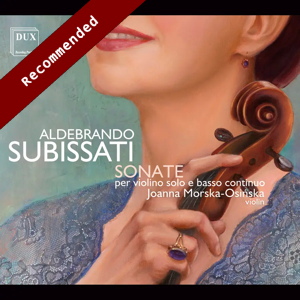
Aldebrando Subissati (1606-1677)
Sonate per violino solo e basso continuo
Joanna Morska-Osińska (violin), Paweł Zalewski (viola da gamba), Filip Michał Zieliński – theorbo, Marek Toporowski (harpsichord), Michał Sawicki (organ)
rec. 2021/2023, Emaus Hall of the St Andrew Bobola National Sanctuary, Warsaw, Poland
Reviewed as a 16-bit/44 kHz download
DUX 1959/60 [87]
In recent years quite a number of discs have been released which are devoted to Italian 17th-century music, performed by Polish ensembles. That is easy to explain: in the 17th century several Italian composers were active in Poland, such as Carlo Farina and Francesco Rognoni. The disc under review sheds light on one of the least-known of these: Aldebrando Subissati. He has no entry in New Grove; fortunately the booklet includes some biographical data.Subissati was born in 1606 in Fossombrone, a town south of the present independent republic San Marino. Interestingly, Piotr Wilk, in his liner-notes, mentions that this was also the birthplace of Ottaviano Petrucci, one of the most famous music printers of the Renaissance. Subissati received his first training as a violinist from his uncle Giulio Subissati, who was maestro di cappella at the Basilica Santa Maria Maggiore in Rome. In the 1630s and 40s Subissati was part of the musical ensemble of the church of San Luigi dei Francesi; he also participated in opera productions and performed as a virtuoso on his instrument. In the early 1640s, he worked in Passau, Olomouc and Vienna, and then, probably in 1645, moved to Warsaw. His presence there is first documented in 1650, when he was in the service of King John Casimir. At the Polish court he was given the title senior musicus, and received a generous salary. In 1654 he was given permission to return to Italy, where he remained for the rest of his life. He settled in Fossombrone, where he was active as a teacher, and may also have participated in performances of oratorios and works for the stage. From the inscription on his gravestone it can be concluded that he also performed for Christina of Sweden, who moved to Italy after her abdication, the consequence of her conversion to Catholicism.
It is not known how much Subissati has written. Apart from three pieces mentioned in inventory records in Cracow (which have been lost), only the set of twenty sonatas that is the subject of the present production is known. The manuscript has not survived complete; in some, sonatas sections are missing, whereas one sonata may have been planned but was not written, and some sonatas include crossings-out and corrections. Wilk concludes that it was not a print-ready copy. He suggests that the collection was the composer’s musical testament. It may have been put together in 1675/76; in 1677 Subissati died. However, the sonatas were probably written much earlier, between 1630 and 1660.
Twelve of the sonatas come with titles in Latin. Eleven of these refer to motets from Antiphonae, seu sacrae cantiones (Rome, 1613) by Giovanni Francesco Anerio (c1567-1630), who from 1624 to 1628 was choirmaster to King Sigismund III of Poland. The motets are based on the basso continuo parts of Anerio’s motets. No model could be found for the Sonata IX Ave virgo. The models are not used for the entire sonata, but only for the first section, and not unaltered, but in the way of diminutions.
The sonatas vary in length: the shortest takes here merely 2:07, whereas the longest lasts 7:48. They are not formally divided into movements; they are written in the stylus phantasticus, in which sections of contrasting tempo and meter follow each other attacca. These works are an impressive testimony of Subissati’s skills as a violinist. They include chromaticism, percussionistic effects and fast repeated notes. They explore the entire range of the instrument and are often quite dramatic. They often reminded me of the Mystery Sonatas by Heinrich Ignaz Franz Biber. The titles refer to Anerio’s motets, and Subissati may have used the basso continuo parts as the foundation for his sonatas, but I wonder whether there is more to them. I don’t know if any attempt has been made to compare the sonatas with the texts of the motets, but that may be interesting. Could it be that Subissati in one way or another has tried to depict those texts in his music?
I am very impressed by these sonatas and do not hesitate to mark them as magnificent; I think it is regrettable that no other works of his have been preserved (assuming he has written more). These pieces are as good as the best that was written in his time by other Italian composers. They are served extremely well by Joanna Morska-Osińska and her colleagues. This is high-class violin playing, and the strong contrasts and many effects in these sonatas are explored to the full. The basso continuo players substantially contribute to the impact of these sonatas. The various combinations of instruments work wonderfully well. This set deserves a special recommendation.
Johan van Veen
www.musica-dei-donum.org
twitter.com/johanvanveen
Buying this recording via a link below generates revenue for MWI, which helps the site remain free.


Contents
Sonata I
Sonata II
Sonata III
Sonata IV
Sonata V Nativitas gloriosae
Sonata VI Capriccio
Sonata VII Si manseritis
Sonata VIII
Sonate IX Ave virgo
Sonata X Sacra spirat
Sonata XI Bonum certamen
Sonata XII Crucis vox
Sonata XIII Domine mi rex
Sonata XIV Exortum est
Sonata XV
Sonata XVI Domine ostende
Sonata XVII Orietur sicut sol
Sonata XVIII Ut audivit
Sonata XIX Medicinam
Sonata XX

















